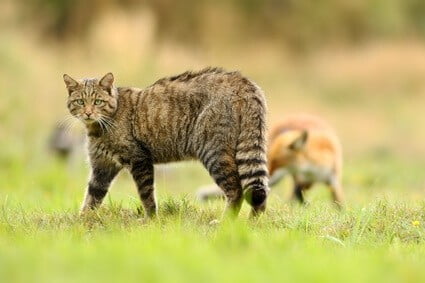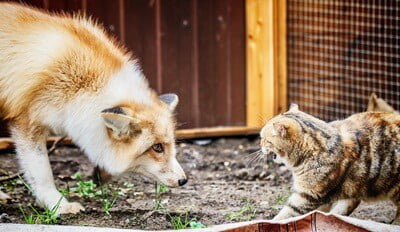Foxes rarely attack cats, but it can happen. Although the risk is small, cats should be kept at a safe distance from foxes to prevent attacks. This is particularly important for senior felines, kittens, and declawed cats.
If you do let your cat outside, an outdoor cat enclosure will provide some extra safety. Secure your yard with a fence, and make sure that the foundations are strong so foxes can’t burrow underneath.
Rather than keeping your cat indoors permanently, you could take steps to deter foxes from entering your yard. Urban foxes are persistent, but there are things you can do to stop them from entering your property.
Will Foxes Attack Cats?
A fox could attack a cat, but it’s very unlikely. Most foxes would not want to get on the wrong side of a cat’s sharp claws. Also, cats are much better climbers than foxes. This makes cats unsuitable prey.
According to BBC Wildlife, an urban fox travels through 100+ cats’ territories each night. If foxes were a serious threat to cats, we’d see many more injuries and deaths.
Many foxes will eat a cat if they come across a cat’s carcass. They are scavengers, so they’ll eat just about anything. However, the act of a fox physically stalking and killing a cat is rare.

How Common are Fox Attacks on Cats?
According to Dr. Wedderburn, between 2010 and 2013, just 14 vet visits out of 10,000 were due to a fox attack. That’s just 0.14% of all vet visits.
According to the same data, the chance of a cat being hurt by another cat is 1.96%, and the prospect of a cat being hit by a vehicle is 5.6%.
Lots of cats go missing each year, and a fox may have killed some of these cats. Even so, most experts agree that foxes aren’t a significant threat.
Cats Most Vulnerable to Foxes
On the rare occasion that a fox does injure a cat, this may be because the cat is vulnerable in some way. Cats are more likely to be attacked if they are:
- A kitten or tiny cat (i.e. under 5lbs.)
- They are outside for the very first time
- They have a limp, or they cannot climb
- Your cat has been declawed
Cats like these are vulnerable to fox attacks but also other threats. They should never be allowed to roam free, especially during the night.
How to Keep Cats Safe from Foxes
While the number of fox attacks on cats is lower than we might think, it’s still prudent to take steps to keep felines safe.
Keep a Cat Indoors at Night
The Cat’s Protection recommends keeping all cats indoors at night. This is to protect them from animal attacks, pet theft, and road traffic accidents.
Foxes come out at twilight (i.e. when it begins to get dark). You should call your cat inside 1 hour before twilight. Give your cat its evening meal at this time so that it has an incentive to come home on time.
It’s possible to spot a fox during the day, but most of their activity is at nighttime, especially urban foxes.
Build a Cat Enclosure
You could install a cat enclosure or Cattio in your yard. The best cat enclosures connect to a cat flap so your cat can come and go as they please.
If you don’t build a Cattio and keep your pet indoors, make sure you provide your cat with indoor activities. Cat furniture, puzzles, and toys will help to keep your feline entertained overnight.
How to Deter Foxes from Your Yard
Once a fox has started visiting your yard, it can be hard to get rid of them. If you want foxes to stay away, you’ll need to make your yard less inviting.
Secure Your Yard
To keep foxes out of your yard, install a fence that runs the full perimeter of your property. Fences with strong foundations are recommended as these stop foxes from burrowing underneath the fence.
Foxes can enter gaps as small as 10cm x 10cm. They’re also able to scale a 2-meter fence.
Keep a Tidy Yard
Foxes love to hide in the long grass. Keep your lawn mown so that it’s less inviting for foxes.
If you have a wildflower bed, put a path around the wildflower bed/lawn. This means the fox will feel exposed if they try to hide in it.
Use Your Yard
Some people stop using their yard once a fox moves in. This is the worst thing that you can do because it will encourage the fox to stay. After all, foxes are shy, solitary creates who don’t want to be disturbed.
The best thing you can do is to start using your yard more often. If your yard is long and thin, put a table and chairs down the end of the yard.
Remove Sources of Food
Foxes will eat just about anything. You might not think it, but there are lots of food sources in your yard.
Bugs, litter, and fertilizers can excite the taste buds of a fox. To deter foxes, consider doing the following:
- Make sure your rubbish is inaccessible. The best way to do this is to place it in a wheelie bin. If you don’t have this option, tie up the bags with a double knot and place them in a bin with a secure lid.
- If you have fruit trees, remove any fallen fruit.
- In urban areas, litter can blow into yards. Remove this litter daily.
- Foxes will eat bread and birdseed. If you want to feed the birds, make sure the feeder is positioned up high.
- Avoid bone meal fertilizers, chicken manure, or fertilizer containing animal blood. The scent will be very appetizing to foxes.

Compost Waste Carefully
Composting is a great way to recycle veg scraps. But if you are not careful, it can attract foxes, rats, and other small scavenger animals.
To prevent this, only put raw fruit and veg in the compost. Do not collect oil, cooked food, or meat as this will attract foxes.
Choose an enclosed compost bin with a lid rather than a compost heap. This can be turned intermittently until it starts to decompose.
Clean Up Fox Droppings
Foxes mark their territory with feces and urine. If you find evidence of this in your yard, clean it immediately. Not only will this reduce the risk of infection, but it will also discourage the fox from returning to your yard.
To clean up fox droppings, use a biological washing power and hot water to break down the substance. You can also use enzyme-based washes.
Hailing
Hailing is an effective tactic, but it must be done consistently. You use your voice and body language to warn off the fox. For example, you may:
- Walk/run confidently towards the fox
- Wave your arms quickly
- Clap your hands loudly
- Jump up and down on the spot
- Shout
- Throw a tennis ball towards them
- Use a whistle or make another loud noise
Foxes are usually very scared of humans so they’ll run away. Inner-city foxes may be less receptive to hailing than suburban foxes because they’ve had more interactions with humans.
Foxes pose a minimal risk to cats. If your cat is declawed, lame or weighs less than 5 lbs, you should still take this risk seriously.


In my experience this article is misleading. We have a significant fox population in our area and I personally have witnessed foxes chasing down healthy, good size, clawed, adult cats in the last month or so. Once, with unfortunate results. They also are out of their den throughout the day and do not limit hunting activities to night time. If you have a fox in your neighborhood, your cat is not safe no matter it’s condition.
Same here. I feed a few stray in the back of my apt, a small wooded area and foxes have been coming for the cat food. Today saw a fox chase a cat, cat screamed and I ran out yelling and clapping. Not a sound after, fox ran off, i hope the cat is okay. Cats have been showing up lately injured and now I know why. Every article claims it’s rare. I guess with less wooded areas everywhere, they are hungry and will attack? I don’t know what to do to deter the foxes but keep the cats safe
4pm – 6 Sept 2023. Yardley Green Road. Birmingham. A Fox made a run at a Cat. Cat did not see it coming, was looking other way at the time. I see the Fox at full speed running at Cat with mouth wide open, head tillted to one side, Fox made no sound at all, I said hello Mister Fox, at this point it stoped dead and went like a Bat out of Hell the other way. The Cat never new it was there. We have 6 Cat in this street, and we have been seeing lots of Foxes in the day the last few Months. The warm winters have led to more Foxes serviving, and there starving.
I too feel that this article is misleading and under estimates the chances of a fox attacking a healthy cat, this is after witnessing my neighbours cat being ruthlessly
attacked. The fox in question was not thin or starving, it in fact looked very healthy alert and practiced in its method, there was no hesitation in its attack at all. It jumped and dragged the fleeing cat down from the fence as it tried to escape then pinned it down, luckily I managed to intervene at that point. Not sure this article is that accurate..
I also think this advice is misleading as my neighbours friendly cat was bitten by a fox on his neck and up to now week 6 his 2 nasty bite marks are slowly healing. It’s really shook him up and he was lucky to have survived that attack. Another fox attack on yet another cat a couple of weeks later. We think that cat escaped before being bitten. The fox left a huge dent in a large pewter pot with the force on his race to miss that cat. We also have had some missing in action cats that I think the foxes have killed and taken. I wish that my neighbours would stop leaving food out at night as this serves as a starter course for the foxes.